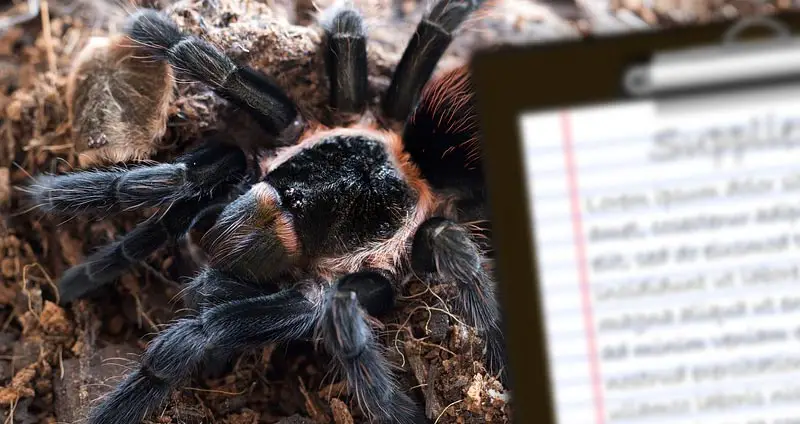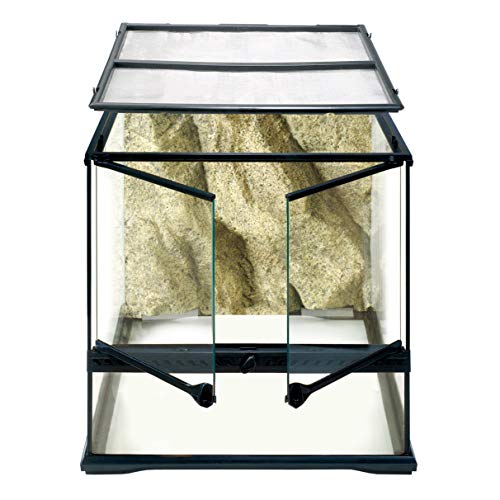Bringing home a new tarantula is extremely exciting! With hundreds of different species, each tarantula is unique and brings something interesting to the table.
Whether it’s your first tarantula or 50th, though, you need to make sure that you have the proper supplies to take care of them.
There are certain enclosure, food, and general care supplies that a well-prepared tarantula owner should have. Tarantulas don’t cost a lot, but lacking any of these supplies could potentially result in improper care of a tarantula which could have some negative effects on the health of your new pet.
Table of Contents
Tarantula Supplies List
Below are 12 essential supplies that tarantula owners should have for their pet tarantula. It’s important to purchase these supplies before bringing home your tarantula so that you can immediately begin caring for them properly.
1. Enclosure
Every tarantula needs to be kept in an enclosure that meets their environmental needs. There are two types of tarantula enclosures — arboreal and terrestrial.
Arboreal enclosures have more of a focus on height, while terrestrial enclosures are all about providing ample floor space.
The enclosure should be substantially larger than your tarantula, and it should be very secure, accessible, and allow for good airflow.
2. Water dish
While many people don’t think about this, every tarantula requires a constant supply of fresh, clean water in order to stay hydrated. It’s not commonly seen, but tarantulas drink water!
Therefore, your tarantula should always have access to clean water that’s kept in water dish.
Get a water dish that’s easy to clean, as tarantulas will dirty it within a day of you cleaning it.
3. Hide
Hides are extremely important for tarantulas’ enclosures. They provide a great place for tarantulas to take shelter and feel safe.
They should be present in both arboreal and terrestrial enclosures as both tarantulas use them equally (which is a lot!).
Hides made out of treated wood or cork bark are most common since they’re natural, durable, and provide a great hiding spot.
To learn more about hides, check out our comprehensive post on tarantula hides.
4. Plants
Placing plants within a tarantula’s enclosure is a great way to make it appear more natural and create a diverse environment for the tarantula to live in.
They are a great object for the tarantula to attach webbing to, and they can also keep water droplets on the leaves for tarantulas to drink from.
Silk vines are very popular, but owners also like to use small ferns and place them in corners of the enclosure.
5. Substrate
Every tarantula enclosure requires substrate. It provides a natural flooring in addition to retaining moisture and allowing the tarantula to form deep burrows.
Terrestrial tarantulas need several inches of substrate to burrow into, while arboreal tarantulas only need about 2 inches.
Make sure that you invest in a substrate that stays fresh for long periods of time and can easily be burrowed into. Coconut fiber substrate is very popular for this reason.
6. Feeding tongs
Whether you have an old world or new world tarantula, you don’t want to be feeding them with your bare fingers. Feeding tongs make the process of feeding much safer.
With these long tongs, you’re able to grab a cricket with ease and place it into your tarantula’s enclosure without running the risk of getting hairs flicked at you.
7. Spray bottle
Many tarantulas require humidity levels in their enclosure between 60% and 80%. Therefore, you’ll need to put effort into keeping their enclosure sufficiently moist.
While a water dish will definitely contribute to higher humidity levels, you’ll also need to mist the substrate with water every once in a while.
This keeps the substrate comfortable and allows it to maintain humidity levels easily.
8. Feeder insect enclosure
Tarantulas thrive off of live prey — primarily crickets and dubia roaches. Therefore, you’ll need an enclosure to house those feeder insects.
A small plastic container with great breathability and accessibility is all that you need.
Just make sure it’s not too cramped, as you don’t want to lose a lot of feeder insects due to improper care.
9. Feeder insects
As stated, tarantulas primarily feed off of crickets and dubia roaches of various sizes. However, crickets are the #1 food choice among tarantula owners.
You can buy several hundred crickets online for very little, and prices only get cheaper as you buy more.
If you’re only keeping one or two tarantulas, you may opt to purchase smaller quantities from a local pet store.
10. Gut loading food
Feeder insects need to eat as well, so food will need to be supplied for them. It’s important to note that their food will also become your tarantula’s food down the line.
Cricket gut load is used to make the crickets as nutritious as possible for your tarantula.
This food can be given to your crickets in addition to fresh fruits and vegetables. This will insure that they’re packed with nutrients so that your tarantula is properly fed.
11. Thermometer / hygrometer
All tarantulas need to be kept in a climate that revolves around certain temperatures and humidity levels. A big part of tarantula husbandry is maintaining those levels.
A thermometer and hygrometer will allow you to closely monitor temperature and humidity within the enclosure, giving you the information you need in order to make appropriate changes.
This is very important as enclosures that are kept at the wrong temperature or humidity can be fatal.
12. Heater
Many tarantulas are fine with being kept at room temperature. However, if your house regularly dips below the safe temperature range for a particular species, you’ll need to provide supplemental heating.
You can go about this two ways. First, you can use a gentle heat lamp that doesn’t emit any light. This can be turned on and off as needed.
You can also use a space heater to warm the entire room that the tarantula is being kept in. This tends to be a bit more comfortable for tarantulas.













